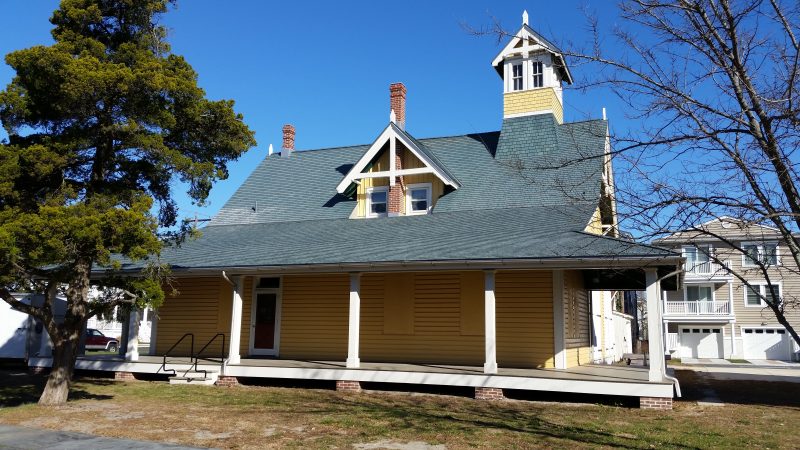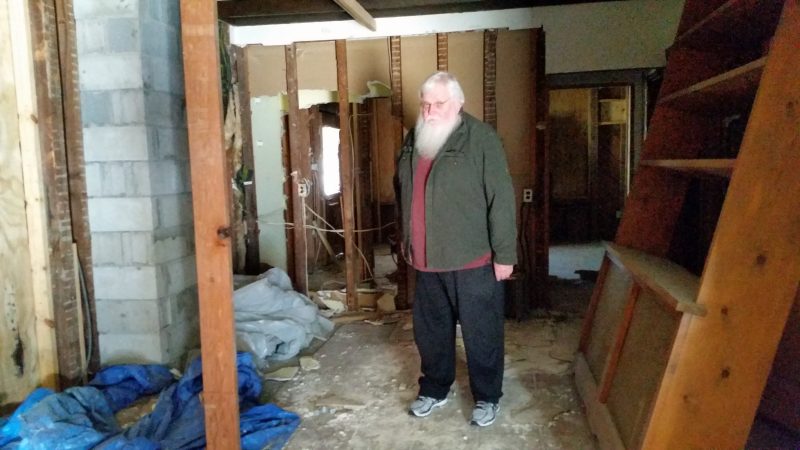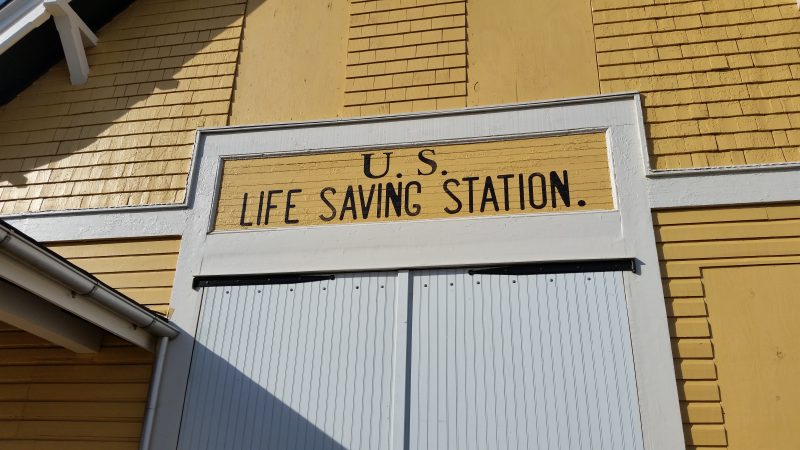John Loeper, chairman of the nonprofit organization overseeing the renovations, stands in what is now the building's gutted interior.

By Donald Wittkowski
Rescuers would peer out from the small “watch tower” on the roof of the Ocean City Life-Saving Station, searching the seas for any distressed or sinking ships. If one was spotted close to shore, the surf men, as the rescue crews were known then, would frantically take action, either launching their lifeboats or deploying a rope-operated system to save the ship passengers. Grueling, dangerous and dramatic, that is how shipwreck rescues unfolded from the late 1800s to the early 1900s at the Ocean City Life-Saving Station, a piece of maritime history that still stands at the corner of Fourth Street and Atlantic Avenue. For years, the old building itself was in need of rescue. The city purchased the two-story structure from private owners in 2010 for nearly $900,000, ending a decade-long battle to save it from demolition. Now, renovations are underway to transform the site into an interactive “living museum” that will recreate the station’s heyday and pay homage to the surf men who risked their lives to save others. “We hope to make this building as period-perfect as possible, so you’ll really get the feeling of what it was like to be in the live-saving service in 1905,” said John Loeper, chairman of U.S. Life-Saving Station 30, a nonprofit organization that is overseeing the renovations and will operate the museum for the city. Construction still must be completed on the windows, doors and interior before the museum will open to the public next year. For now, it remains an empty shell of exposed beams, missing walls and peeling paint. John Loeper, chairman of the nonprofit organization overseeing the renovations, stands in what is now the building's gutted interior.
Loeper estimates it will take 180 days to get the museum ready. A grand opening could happen by Memorial Day weekend, although it would take another month to furnish the building and move in the museum’s artifacts, he said. Admission will be free.
Work has been completed on the exterior, including a new roof and a new coat of yellow paint that matches the original color. The words “U.S. Life Saving Station” have been painted in big, black letters on the side facing the ocean.
One of the most striking architectural features is the tiny "watch tower" on the roof of the building. Loeper noted that the term “standing watch” began with life-saving stations. The surf men literally had to stand up to gaze out of the tower windows while searching for shipwrecks.
John Loeper, chairman of the nonprofit organization overseeing the renovations, stands in what is now the building's gutted interior.
Loeper estimates it will take 180 days to get the museum ready. A grand opening could happen by Memorial Day weekend, although it would take another month to furnish the building and move in the museum’s artifacts, he said. Admission will be free.
Work has been completed on the exterior, including a new roof and a new coat of yellow paint that matches the original color. The words “U.S. Life Saving Station” have been painted in big, black letters on the side facing the ocean.
One of the most striking architectural features is the tiny "watch tower" on the roof of the building. Loeper noted that the term “standing watch” began with life-saving stations. The surf men literally had to stand up to gaze out of the tower windows while searching for shipwrecks.
 The tiny "watch tower" on the roof allowed the surf men to search the ocean for shipwrecks.
As ship travel expanded in the early 19th century, the government made passenger safety a higher priority. The U.S. Life-Saving Service, a government agency, was formed in 1848 to help rescue shipwrecked passengers and crew members. It was a forerunner to the U.S. Coast Guard, which was created in 1915.
Loeper said Ocean City’s station was occupied by the Life-Saving Service from 1871 to 1915. The Coast Guard took over in 1915 and continued to use it for life-saving operations until the 1940s. It was then sold to private owners and became a residence. A succession of owners had it as their private home for decades before the city bought it in 2010.
The renovation project is essentially a step back in time. The building is being converted from a residence into a life-saving station again, right down to the smallest of details to recreate what it was like for the surf men who worked there round-the-clock.
“We’re taking it back between 1905 and 1910, so everyone who comes here will experience a moment in time,” Loeper said. “You’ll feel the building come alive again during that time period.”
Altogether, the purchase price for the building and the cost of renovations will come to about $3 million, according to figures released by Frank Donato, the city’s chief financial officer. The city has been awarded nearly $1.3 million in grants to help pay for the project.
The nonprofit group that will run the museum has raised and invested about $220,000 to acquire artifacts and other materials for the building, city spokesman Doug Bergen said. It has also agreed to share as much as $750,000 in revenue to offset the city’s costs.
“The city has already made a substantial investment in preserving the Life-Saving Station,” Mayor Jay Gillian said. “It’s absolutely important to complete the renovation there, so we can share this piece of our history with the public.”
The nonprofit organization has been busy collecting furnishings and artifacts. Nearly 50 antique chairs, for instance, were acquired from the Christian Brothers complex, the century-old beachfront religious retreat that was demolished in 2014.
The museum will also contain some reproductions for items that are either impossible to find or too expensive to buy. Reproductions will be constructed based on original drawings or blueprints from that period, Loeper said.
Loeper stressed that the museum is appealing to the public for donations. It is looking for life-saving artifacts, furnishings or even mundane household items that date to the late 1800s or early 1900s.
One of the centerpieces of the museum will be a 26-foot-long surf boat, similar in design but bigger, than the lifeguard boats used these days to protect Ocean City’s beaches. The surf boat will be built at the museum as part of an educational project that will give the public an opportunity to see history recreated.
An authentic Delaware duck boat, built in the 1870s, has been donated to the museum. It will be featured in an exhibit that shows how the surf men would hunt waterfowl for their meals.
The Life-Saving Service was a dangerous profession, a fact underscored by its motto: “You have to go out, but you don’t have to come back.”
“Imagine waking up every day, thinking this could be the day you’re going to die saving someone else’s life,” Loeper said.
The museum will honor the 62 surf men who worked at the station from the early 1870s to 1915. Loeper said the nonprofit organization has located the off-shore gravesites of 30 of the men and is researching their backgrounds.
The surf men included Mackey Corson, the life-saving station’s “keeper,” or chief. James Chadwick, another surf man, started Ocean City’s Chamber of Commerce and went on to become a politician, Loeper said.
In conditions considered too dangerous to launch their surf boats, the men would deploy life-saving equipment considered state-of-the art during that time. One was called a “life car,” a buoyant, pod-shaped vessel pulled to shore along a rope line tied to the distressed or sinking ship. The Franklin Institute in Philadelphia is loaning an authentic life car to the museum for permanent display.
The tiny "watch tower" on the roof allowed the surf men to search the ocean for shipwrecks.
As ship travel expanded in the early 19th century, the government made passenger safety a higher priority. The U.S. Life-Saving Service, a government agency, was formed in 1848 to help rescue shipwrecked passengers and crew members. It was a forerunner to the U.S. Coast Guard, which was created in 1915.
Loeper said Ocean City’s station was occupied by the Life-Saving Service from 1871 to 1915. The Coast Guard took over in 1915 and continued to use it for life-saving operations until the 1940s. It was then sold to private owners and became a residence. A succession of owners had it as their private home for decades before the city bought it in 2010.
The renovation project is essentially a step back in time. The building is being converted from a residence into a life-saving station again, right down to the smallest of details to recreate what it was like for the surf men who worked there round-the-clock.
“We’re taking it back between 1905 and 1910, so everyone who comes here will experience a moment in time,” Loeper said. “You’ll feel the building come alive again during that time period.”
Altogether, the purchase price for the building and the cost of renovations will come to about $3 million, according to figures released by Frank Donato, the city’s chief financial officer. The city has been awarded nearly $1.3 million in grants to help pay for the project.
The nonprofit group that will run the museum has raised and invested about $220,000 to acquire artifacts and other materials for the building, city spokesman Doug Bergen said. It has also agreed to share as much as $750,000 in revenue to offset the city’s costs.
“The city has already made a substantial investment in preserving the Life-Saving Station,” Mayor Jay Gillian said. “It’s absolutely important to complete the renovation there, so we can share this piece of our history with the public.”
The nonprofit organization has been busy collecting furnishings and artifacts. Nearly 50 antique chairs, for instance, were acquired from the Christian Brothers complex, the century-old beachfront religious retreat that was demolished in 2014.
The museum will also contain some reproductions for items that are either impossible to find or too expensive to buy. Reproductions will be constructed based on original drawings or blueprints from that period, Loeper said.
Loeper stressed that the museum is appealing to the public for donations. It is looking for life-saving artifacts, furnishings or even mundane household items that date to the late 1800s or early 1900s.
One of the centerpieces of the museum will be a 26-foot-long surf boat, similar in design but bigger, than the lifeguard boats used these days to protect Ocean City’s beaches. The surf boat will be built at the museum as part of an educational project that will give the public an opportunity to see history recreated.
An authentic Delaware duck boat, built in the 1870s, has been donated to the museum. It will be featured in an exhibit that shows how the surf men would hunt waterfowl for their meals.
The Life-Saving Service was a dangerous profession, a fact underscored by its motto: “You have to go out, but you don’t have to come back.”
“Imagine waking up every day, thinking this could be the day you’re going to die saving someone else’s life,” Loeper said.
The museum will honor the 62 surf men who worked at the station from the early 1870s to 1915. Loeper said the nonprofit organization has located the off-shore gravesites of 30 of the men and is researching their backgrounds.
The surf men included Mackey Corson, the life-saving station’s “keeper,” or chief. James Chadwick, another surf man, started Ocean City’s Chamber of Commerce and went on to become a politician, Loeper said.
In conditions considered too dangerous to launch their surf boats, the men would deploy life-saving equipment considered state-of-the art during that time. One was called a “life car,” a buoyant, pod-shaped vessel pulled to shore along a rope line tied to the distressed or sinking ship. The Franklin Institute in Philadelphia is loaning an authentic life car to the museum for permanent display.
 The words "U.S. Life Saving Station" are painted in big, black letters on the building's Oceanside.
The museum has also built a replica of a “breeches buoy,” another life-saving device that was pulled along a rope that functioned similar to a modern-day zip line. Passengers would be placed in a round floatation device with a leg harness attached to it. The rope, tied to the ship, would haul them to shore.
One thing that may perplex museum-goers is the life-saving station’s inland location, more than a block from the ocean. It was not always that way. Loeper explained that a powerful coastal storm in 1902 or 1903 dramatically reshaped the island’s shoreline. The life-saving station, once located on the oceanfront, didn’t move during the storm, but the beach did. A huge swath of sand was pushed in front of the station when Ocean City’s beachfront was reconfigured then.
The building’s renovation has also been a bit stormy, moving along slower than expected while debate continued over what to do with the site. Loeper said supporters have waited patiently for the museum to be completed.
“There’s so much history involved with this building,” he said. “If it’s not told now, it will be lost forever.”
The words "U.S. Life Saving Station" are painted in big, black letters on the building's Oceanside.
The museum has also built a replica of a “breeches buoy,” another life-saving device that was pulled along a rope that functioned similar to a modern-day zip line. Passengers would be placed in a round floatation device with a leg harness attached to it. The rope, tied to the ship, would haul them to shore.
One thing that may perplex museum-goers is the life-saving station’s inland location, more than a block from the ocean. It was not always that way. Loeper explained that a powerful coastal storm in 1902 or 1903 dramatically reshaped the island’s shoreline. The life-saving station, once located on the oceanfront, didn’t move during the storm, but the beach did. A huge swath of sand was pushed in front of the station when Ocean City’s beachfront was reconfigured then.
The building’s renovation has also been a bit stormy, moving along slower than expected while debate continued over what to do with the site. Loeper said supporters have waited patiently for the museum to be completed.
“There’s so much history involved with this building,” he said. “If it’s not told now, it will be lost forever.”